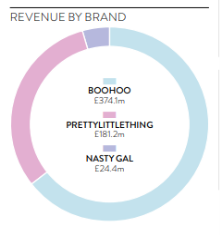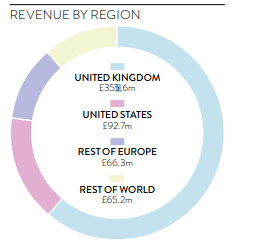Contents
- Executive Summary
- The Company to date
- Strategic Analysis
- Industry Analysis
- Competitive Analysis
- Corporate Strategy Analysis
- S.W.O.T Analysis
- Strengths
- Weaknesses
- Opportunities
- Threats
- Issues impacting the medium and long term equity value of the company
- Brexit
- US/China Trade War
- Bibliography
Executive Summary
The Company to Date
Boohoo Group was founded in Manchester in 2006 by Mahmud Kamani and Carol Kane. The co-founders both had previous experience in wholesale fashion, supplying to retailers such as Topshop and Primark before deciding to launch their online fashion empire; Boohoo.com. Kamani saw the rapid growth in online shopping and was already aware of the massive market for cut-price clothing. On the 14thof March 2014, Boohoo Group soared on its IPO, with shares opening 70% higher than its 50p offer price at 85p. The firm was then valued at £870 million, the success of Boohoo’s market debut highlighted investors hunger and confidence in internet retail stocks at the time. In early 2017 Boohoo Group made the acquisition of the ‘PrettyLittleThing’ and ‘Nasty Gal’ brands which has since boosted the business by increasing market share and dominating the online fashion industry in the UK.
The addition of both brands to the group has undoubtedly been the catalyst to the rapid growth and surge in earnings that we can see in both figure 1.1 and figure 1.2. Boohoo Group’s initial target market was young women, focusing on dresses and ‘going-out’ wear, however the company grew from strength to strength and now targets a much broader group, covering a wide range of items such as menswear, children’s wear, footwear and accessories. As a result of the Boohoo’s expansion and success since its inception in 2006, here is where the company stands to date. For the financial year ended February 2018, revenues of £579.8 million were recorded which is a 97% increase on the February 2017 recorded revenue. As the figure bellow shows, revenues has grown a remarkable 428% since its IPO in 2014. 
Boohoo Group Long-Term Growth Trend Figure 1.1 (Verdict Retail, 2018)
| Date | Type | Turnover £(M) | Profit £(M) | Basic EPS | Currency |
| 28 Feb 2018 | Full Year | 580 | 36 | 2.78 | GBP |
| 28 Feb 2017 | Full Year | 295 | 25 | 2.19 | GBP |
| 29 Feb 2016 | Full Year | 195 | 12 | 1.11 | GBP |
| 28 Feb 2015 | Full Year | 140 | 8 | 0.75 | GBP |
| 28 Feb 2014 | Full Year | 110 | 8 | 0.00 | GBP |
Figure 2.2
As it stands, analysts are putting a large portion of the company’s success down to the building of its portfolio of brands and its overseas expansion. However it is important to note the companies mastering of a number of different business strategy’s before these acquisitions took place, primarily the strategy known as ‘test and repeat’. This involves producing small quantities of a large selection of clothing and then rapidly increasing the production of the items proving to be the most popular and in demand. Most recently, in September 2018, Boohoo Group announced that Irishman John Lyttle, is set to become the companies new CEO as of March 2019. Ms Kane and Mr Kamani will continue in the company as executive director and executive chairman.
Get Help With Your Assignment
If you need assistance with writing your assignment, our professional assignment writing service is here to help!
Strategic Analysis
The aim of a Strategic analysis is to enable one to understand the underlying economics of the company and the industry in which the company competes, highlighting its profit drivers and major areas of risk. In this analysis I will examine the market that Boohoo Group serve and its position in the market, the company’s competitive position and advantage in the market and finally the company’s corporate strategy.
Industry Analysis
Boohoo Group is in the fashion retail industry, an industry that I would describe as ever-changing and constantly expanding with a plentiful amount of new entrants each year and a large market to fuel it. I am going to analyse the sustainability of the fashion retail industry by means of a Five Forces analysis looking at; competitive rivalry, threat of new entrants, threat of substitutes, bargaining power of buyer and the bargaining power of suppliers.
Competitive Rivalry
The fashion retail industry has an intense level of competitive rivalry due to the large number of suppliers offering similar products at similar prices all while often using the same marketing techniques. The concept of brands is something worth looking at when analysing the rivalry in the industry. The brand of an item of clothing is an indicator of its value, quality and often whether or not it is on trend, thus, what way the brand of a company in this industry is perceived as in the market is a key driver of its customer base and loyalty. Some brands in particular such as Nike enable companies to sell items at high prices as the brand is seen as popular and on trend, associated with good quality and style. Boohoo Group’s brand is associated with many famous influences and thus allows it to compete favourable in an intense industry with regard to competition.
Threat of New Entries
The fact that the fashion retail industry is such a heavily populated industry means that new entries must differentiate themselves from the other competitors and take substantial risks in order to achieve success. It is a relatively difficult industry to break into or ‘make a name’ for one’s self, therefore, the threat of new entries is not a huge risk factor in the industry.
Threat of Substitutions
The threat of substitution comes from within the industry itself, this is because although there is little that could substitute for clothing, certain brands can be substituted for others for example consumers turning to Zara to buy high end clothing styles at affordable as opposed to more expensive brands. This threat relates to the bargaining power of the customers as discussed below.
Bargaining Power of Customers
In the case of the fashion industry, customers have significant bargaining power due to the plentiful choice they have. Consumers can drive down the price of particular items of clothing by substituting more expensive items for similar items at a lower cost. Consumers are becoming thriftier in today’s society and thus their bargaining power is increasing. Boohoo Group competed with ‘PerttyLittleThing’ and ‘NastyGal’ for customers before the acquisitions in 2017, with all three businesses attempting to best one another lowering the prices of the similar items they offered. It is clear that in terms of analysing threats facing Boohoo in the fashion industry, the customers themselves have a large part to play with their substantial bargaining power leading to the threat of substitution.
Bargaining Power of Suppliers
The bargaining power of suppliers is very limited in the industry with most companies using suppliers from third world countries who receive mere fractions of the profits. These suppliers can unfortunately be substituted for other suppliers from equally as poor backgrounds who will work for less, thus, their bargaining power is sadly insignificant in the industry.
Competitive Analysis
Master of Industry Strategy’s
As mentioned previously, Boohoo Group are a master of what’s known in the industry as the “test and repeat” strategy. This involves producing small quantities of a large selection of clothing and then rapidly increasing the production of the items proving to be the most popular and in demand. Boohoo Group are able to operate this strategy at such a successful level because they don’t have stores. This means they can experiment without having to worry about keeping stores stocked and have minimal financial risks associated with the trial and error of different items. Hence, Boohoo have a clear competitive advantage over competitors such as ‘Topshop’ and ‘Next’ who have actual stores as well as online shopping when it comes to ‘fast fashion’ (the rapid movement of fashion trends from the catwalk to the customer). Boohoo Group are also making excellent use of celebrity endorsements. Although it may not be a unique strategy, Boohoo’s collaborations such as Boohoo x Paris Hilton or PrettyLittleThing x Maya Jama are proving effective each time. Boohoo Group has undoubtedly mastered the common strategies implemented by competitors in the industry and this ultimately separates it from its rivals.
Cost of Leadership (Market Share)
Cost of leadership refers to how well a company controls and minimalizes its costs in areas such as marketing and facilities. Boohoo Group have done this by increasing their market share in the industry. The acquisition of both ‘PrettyLittleThing’ and ‘NastyGal’ not only brought significant growth to both revenue and global customer base, but also minimalized costs such as marketing as now they are not marketing directly against one another.


Figure 2.1 Figure 2.2
With regard to its operations, Boohoo Group have a successful distribution network in place and have continued to improve it in recent years. Earlier this year they moved their PrettyLittleThing distribution to a new site in Sheffield and is also extending its Burnley distribution centre, both moves result in significant improvements to automation and thus efficiency. The investment into its distribution networks has resulted in faster delivery times and also faster refund times.
Corporate Strategy Analysis
Figure 2.3 (Boohoo Plc Annual Report)
Boohoo Group have a clear vision outlined on their website; to be the leading e-commerce fashion market for a target market of 16 to 30 year olds using four strategic priorities; Insight, Investment, Innovation and Integration. The company’s 2018 Annual Report details how Boohoo Group go about achieving their vision with a simple diagram as presented in figure 2.3. Boohoo Group are a single business firm operating only in the online fashion retail industry.
SWOT Analysis
A SWOT Analysis is an key technique used in any analysis of a company, clearly presenting the Strengths (S), Weakness (W), Opportunities (O) & Threats (T) that in this case are associated with Boohoo Group as a company.
Strengths
|
Weaknesses
|
Opportunities
|
Threats
|
Strengths
- Expansion (both in the U.K and Globally)
Boohoo Group has seen a significant expansion in their market share after the acquisition of both ‘PrettyLittleThing’ and ‘NastyGal’ which has led to a greater share in the market and a broader customer base.
- No tie to physical stores
Boohoo Group are not responsible for any actual stores, this provides them with the flexibility to experiment with new items and to scale up and scale down based on the demand conditions in the market.
- Reliable distribution network
Boohoo Group have built a up a reliable reputation when it comes to the distribution of its products and now has a proven successful shipping model that can reach all of its’ customer base.
- Portfolio
Boohoo Group have expanded their portfolio in recent years and have a positive track record in relation to integrating these companies through mergers & acquisition.
Weaknesses
- Lack of investment in technologies
As mentioned previously, Boohoo Group are expanding rapidly given the scale of expansion and different geographies the company is planning to expand into, it is vital Boohoo Group invest a significant amount of money in technology in order to integrate the processes across the board.
- Lack of innovation
Although Boohoo Group keep up with current trends, the company’s fashion developments are usually a response to other players in the game (ASOS and Missguided).
- E-commerce laws
For any online retail company there is always a weakness there in getting to grips with e-commerce and the laws entailed with it as they are constantly updating and tightening, for example the introduction of GDPR regulations this year. Boohoo Group need to be constantly aware of customer rights.
Opportunities
- Global Market Expansion
With Boohoo Groups recent expansion into the global markets through acquisitions, this brings opportunities to reach out to countries of different styles thus an opportunity for new products to be introduced.
- Smart Phone expansion
There is also a significant potential for an increase in use of mobile sites of Boohoo.com and PrettyLittleThing.com. With the ongoing expansion of smartphone ownership into international markets, more and more customers are using their smartphones to shop online. According to a report by Deloitte, nearly every developed country boasts smartphone penetration rates of 80%, this could result in further expansion to global markets.
- Technology Advances
Technology advances occurring globally each year provide online companies such as Boohoo Group the opportunity to increase efficiency and reduce costs.
- New trends
New trends in the consumer behavior open up opportunities to companies in the fashion industry to introduce new products and expand their clothing ranges. Diversification of products is essential for companies to remain current and on trend.
Threats
- External Economic Factors
Economic factors at the moment such as ‘Brexit’, the US/China trade war and the 2019 Italian budget are causing volatility and uncertainty for investors in the market at the moment.
- Currency Fluctuations
As Boohoo Group is operating in several countries it is exposed to currency fluctuations, particularly given the volatile political climate as mentioned above in the markets across the world.
- New environment regulations
New environmental regulations being enforced in recent years (e.g. The Paris Agreement 2016) could be a threat to certain existing product categories.
Issues Impacting the Medium and Long-Term Equity Value of the Company
The Equity Value of a company is the value of the company that remain for shareholders after debts have been paid. The Equity Value takes into consideration the factors that might not impact the company at present but may affect it at any time. Equity Value is a good indicator of a company’s growth potential as it fluctuates daily with the stock market. In my opinion there are two major themes in today’s global markets that may affect the equity value of businesses based in the EU including Boohoo Group; Brexit, and the US/China trade war. These factors are particularly affecting the medium-term equity value of the company as they are influential topics in today’s markets and short-term investors are monitoring them closely whilst basing important decisions upon them.
Find Out How UKEssays.com Can Help You!
Our academic experts are ready and waiting to assist with any writing project you may have. From simple essay plans, through to full dissertations, you can guarantee we have a service perfectly matched to your needs.
View our academic writing services
Brexit
Brexit is a hot topic at the moment with the possibility of the recent withdrawal agreement being rejected by the British Parliament thus adding fuel to the possibility of a ‘no deal’ Brexit. No withdrawal agreement would mean barriers to trade between U.K. and EU countries would go up, thus affecting Boohoo Group. Although there seems to be a rally around the pound at the moment, this is liable to change any day, such volatility in the markets leave investors unsure when it comes to their investments in U.K. based firms. As outlined previously in this report, a significant amount of Boohoo Groups revenue comes from outside of Britain. Much of the company’s growth prospects are dependent on a global increase in their customer base. Brexit has put a cloud of uncertainty across the future of Boohoo Groups cross boarder trading, investors crave certainty and stability and company’s based in Britain who export to the EU and U.S do not provide such certainty. Should the turmoil around Brexit intensify, the share price of all British companies may decrease, thus affecting its equity value.
US/China Trade War
Regardless of where a company is based in the world, a trade war, more precisely and increase in tariffs affects every company. Tariffs increase the cost of exporting and importing goods for all countries by increasing trade deficits which adds to global debt. The added tax on Chinese goods by the U.S forces Chinese retailers to push up the price of their locally produced equipment, thus increasing the cost of products and technologies for e-commerce retailers such as Boohoo Group across the globe. An increase in costs for Boohoo Group will ultimately have a knock-on effect to profits and thus earnings of the business. This trade war, like Brexit, is adding uncertainty to the markets which is creating a ‘bear’ market. Investors are now risk averse and reluctant to make new investments in companies until issues in the global economy settle again. When looking at the long-term equity value of the firm it is important to think about what exactly long-term investors are looking for in companies. Have the company’s products a durable competitive advantage? Can the company survive through tough stretches?
Bibliography
- http://fernfortuniversity.com/term-papers/swot/nyse/6728-boohoo-com-plc.php
- https://www.ft.com/content/f1a24648-3a19-11e7-ac89-b01cc67cfeec
- https://www.drapersonline.com/retail/ecommerce/the-drapers-interview-carol-kane-and-mahmud-kamani-co-founders-boohoo/5074500.article
- https://www.rte.ie/news/business/2014/0314/602214-boohoo-ipo/
- https://www.ft.com/content/f1a24648-3a19-11e7-ac89-b01cc67cfeec
- https://pestleanalysis.com/five-forces-analysis-of-fashion-retail-industry/
- https://internetretailing.net/strategy-and-innovation/strategy-and-innovation/boohoo-group-on-what-makes-it-successful-18430
- https://www.scmp.com/news/world/europe/article/2153860/collateral-damage-us-china-trade-war-europe-could-be-big-loser
- https://www.thebalance.com/signs-a-stock-might-be-a-good-long-term-investment-4108162
Cite This Work
To export a reference to this article please select a referencing style below:



